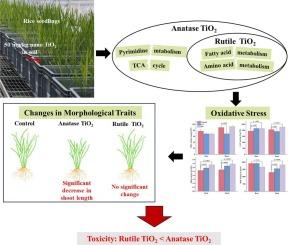多组学方法揭示了暴露于锐钛型或金红石型TiO2纳米粒子的水稻(Oryza sativa L.)在毒性和机理方面的差异。
IF 4.7
3区 环境科学与生态学
Q2 ENVIRONMENTAL SCIENCES
引用次数: 0
摘要
二氧化钛纳米粒子(TiO2 NPs)已被广泛用于农业,这增加了对土壤-植物系统的风险。研究表明,TiO2 NPs 可诱发植物毒性。然而,有关毒性机制,尤其是不同结晶形态的TiO2 NPs在胁迫下的毒性机制的报道仍然不足。本研究结合转录组学和代谢组学分析了水稻(Oryza sativa L.)在锐钛型(AT)或金红石型(RT)TiO2 NPs(50 mg/kg,40天)胁迫下的毒性机制。暴露于 AT 后,水稻芽的长度(减少 1.1 倍,p = 0.021)和丙二醛浓度(减少 1.4 倍,p = 0.0027)显著减少,而暴露于 RT 后未观察到显著变化。AT 组和 RT 组的抗氧化酶活性都发生了显著变化,表明二氧化钛纳米粒子诱导了水稻氧化损伤(变化 1.1 至 1.4 倍,p = 0.0027)。基于观察到的不利影响,该研究强调,在水稻生态系统中应谨慎使用任何形式的 TiO2 NPs。这项研究首次证明,在水稻生态系统中,AT 比 RT 的毒性更大,为了解不同晶体形态的 TiO2 NPs 的不同影响和毒性机制提供了重要依据。这些发现建议,在农业发展中需要使用 TiO2 NPs 时,应优先使用 RT,以最大限度地降低毒性风险。本文章由计算机程序翻译,如有差异,请以英文原文为准。

A multi-omics approach reveals differences in toxicity and mechanisms in rice (Oryza sativa L.) exposed to anatase or rutile TiO2 nanoparticles
Titanium dioxide nanoparticles (TiO2 NPs) have been widely used in agriculture, which increased the risk to soil-plant systems. Studies have demonstrated that TiO2 NPs can induce phytotoxicity. However, the toxicity mechanisms, particularly under the stress of TiO2 NPs with different crystalline forms, remain inadequately reported. In this study, we combined transcriptomics and metabolomics to analyze the toxicity mechanisms in rice (Oryza sativa L.) under the stress of anatase (AT) or rutile (RT) TiO2 NPs (50 mg/kg, 40 days). The length (decreased by 1.1-fold, p = 0.021) and malondialdehyde concentration (decreased by 1.4-fold, p = 0.0027) of rice shoots was significantly reduced after AT exposure, while no significant changes were observed following RT exposure. Antioxidant enzyme activities were significantly altered both in the AT and RT groups, indicating TiO2 NPs induced rice oxidative damage (with changes of 1.1 to 1.4-fold, p < 0.05). Additionally, compared to the control, AT exposure altered 3247 differentially expressed genes (DEGs) and 56 significantly differentially metabolites in rice (collectively involved in pyrimidine metabolism, TCA cycle, fatty acid metabolism, and amino acid metabolism). After RT exposure, 2814 DEGs and 55 significantly differentially metabolites were identified, which were collectively involved in fatty acid metabolism and amino acid metabolism. Our results indicated that AT exposure led to more pronounced changes in biological responses related to oxidative stress and had more negative effects on rice growth compared to RT exposure. These findings provide new insights into the phytotoxic mechanisms of TiO2 NPs with different crystalline forms. Based on the observed adverse effects, the study emphasizes that any form of TiO2 NPs should be used with caution in rice ecosystems. This study is the first to demonstrate that AT is more toxic than RT in paddy ecosystems, providing crucial insights into the differential impacts and toxic mechanisms of TiO2 NPs with different crystalline forms. These findings suggest prioritizing the use of RT when TiO2 NPs are necessary in agricultural development to minimize toxicity risks.
求助全文
通过发布文献求助,成功后即可免费获取论文全文。
去求助
来源期刊

NanoImpact
Social Sciences-Safety Research
CiteScore
11.00
自引率
6.10%
发文量
69
审稿时长
23 days
期刊介绍:
NanoImpact is a multidisciplinary journal that focuses on nanosafety research and areas related to the impacts of manufactured nanomaterials on human and environmental systems and the behavior of nanomaterials in these systems.
 求助内容:
求助内容: 应助结果提醒方式:
应助结果提醒方式:


